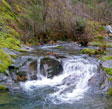by Dr. Austin following the Sea Ranch Forum
And Davidge’s answers
Introduction:
Ric Davidge was invited to speak at the Sea Ranch Forum on Saturday, March 16, 2002. Mr. Davidge is president of Alaska Water Exports, the company which has applied to the State Water Resources Control Board (SWRCB) to extract bulk fresh water from the Gualala and Albion Rivers.
The audience had many more questions than were able to be addressed during the Forum. Mr. Davidge agreed to answer all of the questions submitted. He sent his reply to the Forum committee on May 24th.
Note: The following questions were developed after the Forum. They were inspired by the Forum and by subsequent e-mail exchanges between Mr. Davidge and Dr. Austin.
Additional questions for Mr. Davidge submitted by Dr. Austin after the Forum:
General Answer: Although I have been very open in discussing the technical aspects of bag and tug operations, it is not in our interest to be specific in the dimensions, technologies, operations, etc of our bag/tug systems as they are considered to be proprietary/trade secrets. The bags that you have seen in videos of operations in the Mediterranean are not the bags that will be used in the Pacific or Atlantic for a number of reasons.
First, we must comply with the Jones Act and second we must meet U.S. Coast Guard vessel licensing requirements. Finally, we design or craft a delivery system unique for each project to ensure the highest level of efficiency and economies. One project will most likely not be comparable with another due to a host of variables. The submission of proprietary information to regulatory agencies can be protected under appropriate regulations of that agency.
- What is the shape of the bag?
Answer: Other than what you have seen in the videos we do not discuss the specifics of our bag systems as we consider that proprietary. - What is the length of the bag you will use from tip to tip?
Answer: We do not discuss the specifics of our bag system as it will be applied in the Pacific as we believe that information is proprietary. - What measurements or data do you have to support your rationale for drawing 140-170 cfs from the Gualala River?
Answer: That is the recommendation of the engineers and hydrologist working together. This flow level will fluctuate to ensure that a bag can be filled within 24 hours during harvest season. - What data do you have that shows river flow rates as a function time during the winter season when you plan to fill and deliver bags?
Answer: We have provided the state with a copy of our hydrologic assessment based on USGS records that are public information. - Are you planning on using a Renney type collector? If not, what?
Answer: (delegated to engineering) - What hp is needed to pump the water through the proposed 2′ diameter, 7700ft long pipe line?.
Answer: (delegated to engineering) - Will the pumps be electric or diesel powered?
Answer: Electric based on current design. - What infrastructure is planned for the pump house, docking, hookup method, and night operation lighting?
Answer: The offshore pumps will be housed under the buoy. We do not anticipate moving a bag at night for safety reasons. - How many bags/ 24 hr.day, over what period of the year, will you fill from the Gualala River?
Answer: That depends on seasonal flow. - What tug hp and velocity will you use on your run to San Diego?
Answer: That depends on sea conditions and the preferences of the tug company. Different style tugs use different hp to move a load. - What is the maximum towline tension you must accommodate?
Answer: (delegated to towing consultant) - What is the mean lifetime of a bag?
Answer: These are new generation bags. The manufacturer believes they will last seven to ten years. - Where will your repair facilities be located?
Answer: Although we had initially selected a site, the tug company is now reviewing that and may suggest alternative sites based on their needs. Furthermore, the bag manufacturer will determine the appropriate location of a bag repair facility. - Show your calculation of the fluid drag on the bag. Is it either flat plate skin friction or profile drag or both.?
Answer: That is proprietary - What is depth (draft) of bag.?
Answer: The depth of the bag changes from loading to towing. Bag dimensions are considered proprietary. - How is bag hooked to deliver pipe? From the tug, or from a platform?
Answer: From the buoy. - What is your rationale for pipe diameter, flow rate, head loss from pipe friction and fittings?
Answer: It is the recommendation of the engineers in order to allow one bag to be filled within 24 hours.
 Friends of Gualala River Protecting the Gualala River watershed and the species living within it
Friends of Gualala River Protecting the Gualala River watershed and the species living within it
